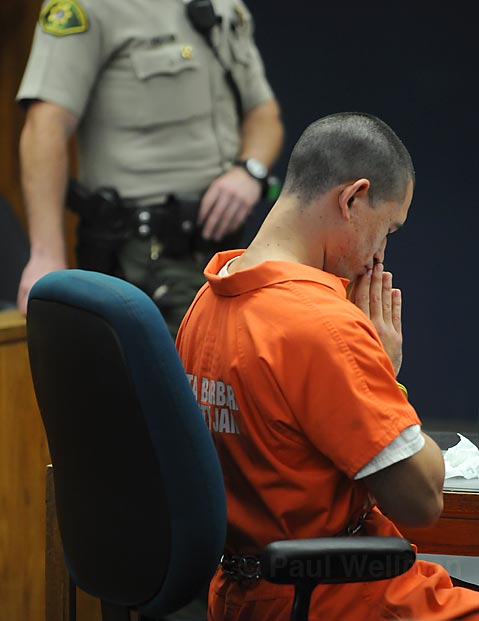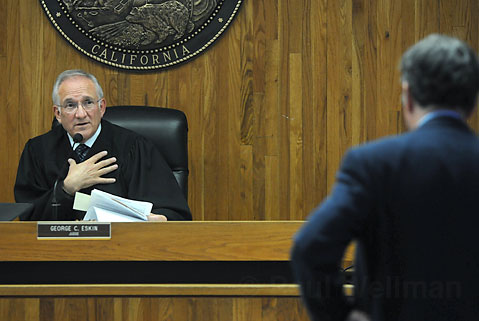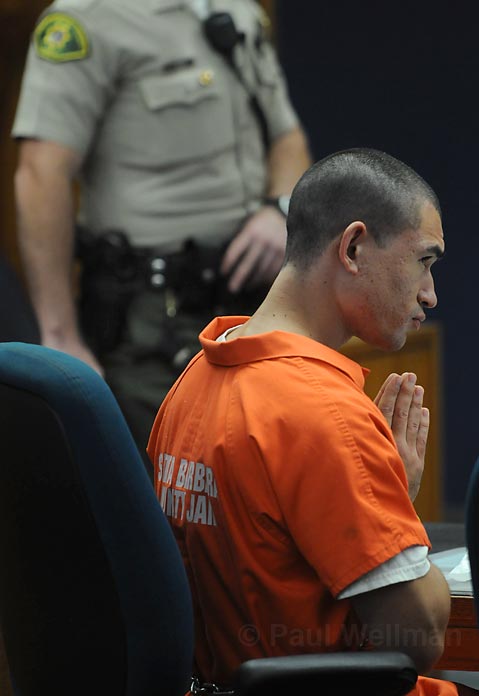Overpass Gunman Gets Reduced Bail
Debate Arises over Van Tassel's PTSD Validity

On November 12, the day after that holiday that honors those who have served or are currently serving in the United States military, the fate of one Iraq veteran was the subject of heated discussion at the Santa Barbara County Superior Court, as Judge George Eskin handed down his decision to reduce Edward “Kyle” Van Tassel’s bail from $250,000 to $50,000. Van Tassel, 29 – the man who stood on the La Cumbre overpass on November 3, waving an unloaded 0.38 caliber pistol – appeared in on Wednesday to find out if he would be released from jail while his trial is underway. Having completed a mental health evaluation of Van Tassel, pretrial services recommended that he be released on his own recognizance to enable him to receive proper psychiatric treatment at the Veterans’ Administration Clinic.

According to court documents reviewed at yesterday’s hearing, Van Tassel – who was allegedly diagnosed by Walter Reed Medical Center staff as having Post Traumatic Stress Disorder (PTSD) after returning from a deployment in Iraq – had failed to take his anti-depression medication when he staged his overpass demonstration, which was reportedly staged in protest of the current war in Iraq and to solicit votes for Barack Obama. In a statement made under oath, Van Tassel’s mother, Patria, said that her son had been a vocal proponent of Barack Obama in the weeks leading up to the election. Van Tassel, who last served in the Army’s 192nd Infantry Brigade, received an honorable discharge from Walter Reed in October 2005. Although a typical enlistment lasts four years, he served only two and a half.

With hands clasped and head bowed, Van Tassel maintained an prayerful pose, breaking it only to sign some court documents handed to him by Robert Landheer, his attorney. Landheer’s stated goal was to get his client – whom he is representing pro bono – out of the county lockup and into the New Directions Care Center in West Los Angeles, a facility that is part of the services offered to Iraq veterans by the Greater Los Angeles Veterans Healthcare System. Landheer said that the $250,000 bail which had initially been set made it impossible for Van Tassel to get the treatment he needed. “There is no danger that he will not show up [in court], and I don’t believe he is a public danger,” he said. Landheer also obtained pro bono services from a psychologist who examined Van Tassel’s Army medical records to confirm that he was diagnosed with PTSD.
Darryl Perlin, the senior prosecutor for the Santa Barbara County District Attorney’s office, was not convinced that PTSD had much to do with Van Tassel’s overpass demonstration. Beginning his presentation with a powerpoint slideshow outlining Van Tassel’s mental history, he was stopped by Eskin, who objected to the publication of confidential information. “This is the lynchpin in the People’s case; that he is not suffering in the way you’ve been led to believe,” said Perlin, who stated his doubt that Van Tassel exhibited signs of PTSD at all. Several of Van Tassel’s family members, who were in the courtroom, were visibly miffed by Perlin’s comments, as were Lane Anderson and Philip Marteney – two Veterans for Peace activists in attendance. Eskin said that he believed the diagnosis to be valid, and expressed his extreme displeasure at Perlin’s repeated references to Van Tassel’s “so-called Iraq experience.”
In a verbal tug-of-war that lasted for hours, Perlin continued to attack the credibility of Van Tassel’s PTSD diagnosis. Noting from court documents that Van Tassel had broken up with his girlfriend on October 19, Perlin speculated that the overpass demonstration, and an alleged break-in at the KJEE radio station on October 31, were motivated more by personal reasons and rational decision-making than by PTSD, the war in Iraq, or the election. Perlin said that he based his assumption on Candace Holmes‘s pretrial mental health assessment, in which Van Tassel reportedly said that his goals included gaining the respect of his girlfriend. He also pointed out a mention in the court documents of a trip Van Tassel made to Las Vegas in 2007, where he allegedly experimented with methamphetamines. “Does that sound like the actions of a war veteran with PTSD, or someone who made a conscious decision to use illegal drugs?” he queried. “Both,” replied Eskin.

Acknowledging that someone could have been hurt if police had opened fire on Van Tassel during the standoff, Eskin maintained that the only damage done was the huge inconvenience caused by hours of traffic on the freeway. An argument ensued between Perlin and Eskin about the loss of life that could have occurred as a result of Van Tassel pointing an unloaded pistol at a police officer, but Eskin concluded that most of the danger was to Van Tassel himself. He praised the discretion shown by law enforcement on scene, and said that Van Tassel is lucky to be alive.
When Eskin rendered his decision to reduce bail to $50,000, Van Tassel said that he understood, but that he would not be able to make bail. “You have a lot of supporters who can help you out,” said Eskin. There are strings attached if Van Tassel is released. He will be required to stay at the New Directions Center, and they will have to transport him to and from Los Angeles and his court appearances in Santa Barbara. Furthermore, contact with Aaron Jacob Levy – the 33-year-old Santa Barbara man charged with conspiracy for driving Van Tassel to the overpass – is forbidden.
Perlin was concerned that if released, Van Tassel would be in an unlocked care center without 24-hour supervision, but Eskin posited that the bail amount and the prospect of being returned to jail would be sufficient in keeping him from violating the terms of his release. “It is ironic that this should come before the court the day after Veterans’ Day : when we pay great lip service to those who have sacrificed so much,” he said.
“I personally think he did a heroic act,” said Marteney, who served for 14 months in Vietnam as an Army draftee from 1970-1971. “He brought an issue to the attention of thousands of people and did no harm to anybody.”
Van Tassel’s preliminary hearing is scheduled for November 20.



